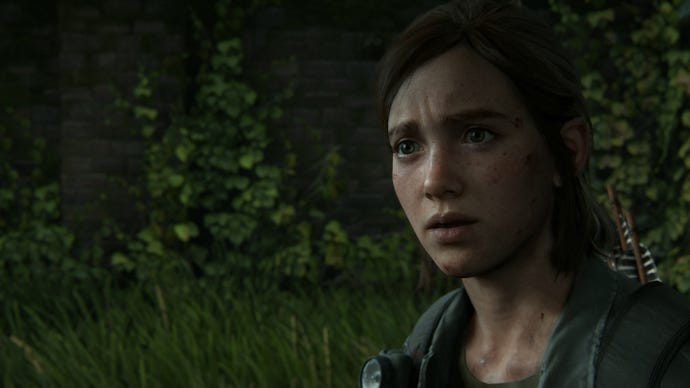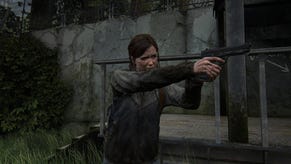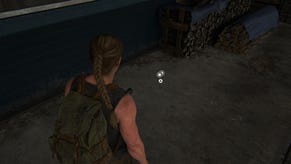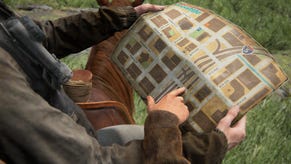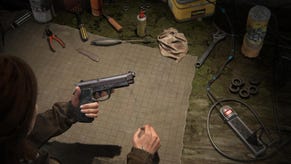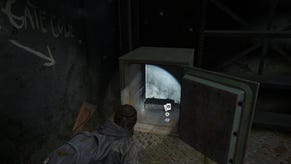Naughty Dog Wants The Last of Us Part 2's Combat To Make You "Vulnerable"
The Last of Us Part 2's lead game designer tells us about how AI has been overhauled for both enemies and companions, and more.
This article first appeared on USgamer, a partner publication of VG247. Some content, such as this article, has been migrated to VG247 for posterity after USgamer's closure - but it has not been edited or further vetted by the VG247 team.
The Last of Us is at its best on its Survivor mode difficulty. For how brutal the combat looks, it never feels as intense in action. In my few playthroughs of The Last of Us over the years, on Normal I'd be sitting pretty on a stockpile of makeshift grenades and ammo, and consequently never felt like I was ever in palpable danger. On Survivor, goods are always scarce, and encounters are in turn actually frightening. It feels almost like how it was intended to be experienced.
After playing the first demo for The Last of Us Part 2 at a recent event, I got a little worried. It was a bit boring, to be honest. As Ellie, I looted houses in the snow alongside Dina, her crush introduced in the E3 2018 trailer. It's quiet and slow, and as the two talk, we get more insight into how Ellie's been doing since we last saw her. Her relationship with Joel, the protagonist from the first game, sounds strained. Ellie awkwardly says she's going to watch a movie with him when Dina asks if she has plans for the night. "Are you two good?" Dina asks shakily, to which Ellie quickly changes the subject to explaining the silly plot of the corny '80s action movie she's planning to watch.
Still, what we were doing—exploring houses, grabbing familiar nuts and bolts and other scraps for crafting—wasn't really compelling in the way Uncharted 4's walking simulator-like epilogue was. Eventually, we got into familiar scrambles with Infected as the tutorialized section taught us all over again how to take out Clickers and Runners, respectively. It reminded me why I don't remember the Infected encounters of The Last of Us as fondly as, well, the rest of the game.
Monsters, AI, Oh My!
"The Infected is still a huge part of our game," lead game designer at Naughty Dog, Emilia Schatz, tells me when I ask how that particular brand of enemy has evolved now that it's five years after the events of the first game. "They provide the overall setting that allows us to explore the characters, and so they are sort of a constant presence, but a lot of times not the main sort of threat because they're more of an environmental threat."
The Infected being an environmental-specific threat is context I hadn't thought of before. For instance, when I explored a basement at one point, I came across two "Shamblers." Shamblers are a new enemy type that exudes a toxic gas, but is blind like the Clickers. They were tough to take down, but since they're slow, it doesn't feel impossible. I set down a proximity bomb, baited them to walk into it with a brick toss, and then took out a shotgun. Easy peasy.
Another aspect that returns in The Last of Us Part 2 is the occasional AI companion. In the original game, the companion AI is infamously a little finicky. I've seen comical screenshots players have shared of Joel crouched behind a ledge in a tense scenario, with Ellie standing in full view of any enemy in the area. Schatz assures me that won't be the case again in The Last of Us Part 2.
"That's basically had a huge overhaul," Schatz says. "So the A.I. of your buddies is a lot more robust in being able to get out of your way [...] and also be helpful. They're able to sneak through environments in a way that it was just impossible to do on the PS3 because we were very limited in our resources to do anything. We started with development of buddy stealth in Uncharted 4, so your brother Sam was able to sneak through environments to a certain degree. In The Last of Us Part 2, we've really done a huge step beyond that—they stay out of your way. [...] They stay hidden and, yeah, it's a huge improvement on that."
Enemy AI has seen its own overhaul too, according to Schatz. Enemies now tend to work together, more than the usual "report in," call out that's a staple in a lot of stealth-action games. (Of course, they still do that too, but are more likely to investigate when someone goes radio silent from what I saw.) "It's very hard to sneak up on one without alerting the others," says Schatz. "It really requires a lot of more finessing." The AI evolution came in part with the new level design goal within Naughty Dog: to make environments more open. It's less open-world or God of War hub-like than it sounds. It's more like instead of just one small corridor, there are now many side areas you can pop into along the main route.

This design sensibility is most evident in the second demo I played, situated a few hours ahead in the game. It's also in this demo, compared to the one before it, where The Last of Us Part 2 is more intriguing from a gameplay perspective. In this demo, I'm roaming the suburbs of Seattle as Ellie. I discover that not only can she crouch as usual, now she can lie prone in grass too. The grass height is never consistent; it can be really shallow or very tall. This idea also started in Uncharted 4, only here, it's less binary. You're never really completely safe or hidden. If someone walks up to you while you're lying down in the grass, they'll spot you. As Schatz tells me, hiding in general is much more of a "gray area."
"The more we experimented with it, the more it really felt like it got to the heart of the experience of The Last of Us," says Schatz. "Being in prone means you're a lot more vulnerable, so I love how that ties into how we're depicting Ellie as a character for instance. Like Ellie is, when you see the first part of the demo which takes place in the snowy Wyoming, you see the development of her and her friend. You can really tell she's holding back.
"Ellie is such a complex character that you could see [her] vulnerability and how much she is capable of caring, but then we see another part of the game where you can see how she's capable of great violence and vengeance. So it pairs very much with when you're prone. You're very vulnerable, but you are able to sneak up on people. Pretty much all of our gameplay mechanics try as best as they can to sort of overlap with a lot of our gameplay themes, of our narrative themes."
At the start of the Seattle demo, I don't really encounter humans. Ellie rummages through houses alone, stealing scraps and reading notes about the people who lived here and stood their ground against all sorts of intruders. One man, according to his kid, was really good at taking out Infected with a bow and arrow. He even had an archery trophy. Later, an Infected attacks me when I enter what I thought was an empty garage with—surprise, surprise—a bow strapped to its back. Ellie clutches it from their literal likely-still warm dead hands; reunited at last with a sweet, sweet silent bow.
Humanizing Ellie's Foes
In the first major encounter in this demo, a new enemy type is introduced: dogs. Dogs are dangerous because they can sniff you out. With your Batman-like listening, you can even see where their scent is tracking you and try to distract it in turn. To escape its scent, I snaked through a building, hoping to take out one of the enemies on patrol that didn't have a dog at their side. I ended up making them more suspicious. It was when the action popped off that The Last of Us Part 2 started to make me really uncomfortable, but in a fascinating way. Enemies shout each other's names when someone dies; when I killed a dog running at me, their owner cried out in a way that made me a bit sad, even.
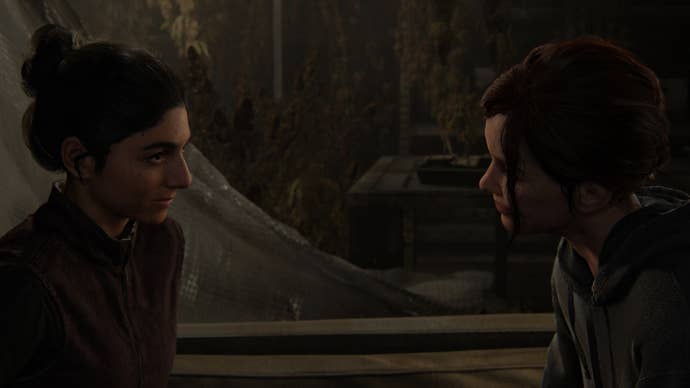
It's come a long way from that shocking trailer of the first game that ended with Joel shotgunning someone in the face. And The Last of Us Part 2 isn't holding back either on making players feel wrong. The feeling bubbles to the surface every time an NPC cries out a fallen comrade's name that you just killed. "Yeah it is really uncomfortable and that's what we're going for: A sense of discomfort with what Ellie is doing, what the player is doing," Schatz says. "There are consequences to actions, but at the same time, you feel like it's justified or you feel like it had to be done. We're really interested in how that inspires a circle of violence.
"So in The Last of Us Part One, we follow Joel on this journey, and he did a lot of very terrible things. Towards the end of the game, you kill some doctors in order to save Ellie. Personally, I felt very divided about that, but I could see why he did that. And I don't think I can really blame him; and at the same time that was an awful thing and I didn't feel that comfortable with it. That's really where I feel we could really get to a good place about trying to explore what human nature is; who we are and who these characters are. So that's a space that we'd really like to get into."
Separate from the event I attended, a new trailer for The Last of Us Part 2 premiered during Sony's State of Play livestream. The trailer heavily implies that Dina is killed while they're out on a patrol, and that's what sends Ellie on this vengeful journey. I ask about the trailer, because after the events of The Last of Us' standalone Left Behind DLC also covered a love interest of Ellie's dying in a horrible way, I'm left with the question: why this, again?
"I don't want to speak too much to the initial story is—the trailer's just a trailer—but, you know, this is a, it's a pretty dangerous world," says Schatz. "And the advantage of a world where there isn't really a law and order means that we can explore the issues of like what happens when something bad happens, and you need to make it right. How even with the best intentions, even with righteousness, when you go out and do acts of violence, there are consequences to it. That's why it's so important for us to show a sense of consequence by humanizing our enemies, for instance."
I'm still not entirely convinced by why The Last of Us Part 2 needs to exist, narratively. According to Schatz, this will be "the longest game Naughty Dog has made," which already sounds exhausting. The demos I played and subsequent trailer did little to convince me why the first game needs a sequel, considering how perfectly contained the original's story is.

Yet walking away from the hours I played, how intense the combat felt has stuck with me. It's in many ways what I always wanted the original to feel like, but only got a sneeze away from in its Survivor difficulty. There were moments that made me feel nasty; like killing a man's dog and hearing him cry out in grief for it, or bringing a hatchet down into a woman's head. Another moment had me feverish, as I ran out of all my ammo and frantically ran around in search for the exit or a tuft of grass to lie down in. It's alarming and gnarly in all the ways it should be—just like that end sequence in the original game. It doesn't feel "empowering," or some other buzz word. It feels foul, as it should be.
But the story, which Schatz tells me directly reckons with such violence, will also have to be key in bringing this all together. Right now, I haven't seen enough to surmise whether it will be as affecting as the original game was. For now, at least, the gameplay feels like a step forward from the original. It's what left the biggest impression on me during my hands-on, which is strange, considering outside of a few specific encounters in the first game it's maybe what I liked the least about it all.
It actually won't be long now until everyone gets their hands on Naughty Dog's latest adventure, when The Last of Us Part 2 launches on PlayStation 4 on February 21, 2020. (Just don't expect any multiplayer this time around.)
